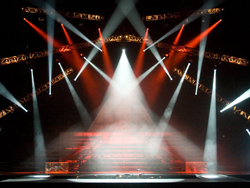
Alternately, you could use a random playlist on an MP3 player; just ensure that it plays various types of music. Play back your programming to the various music types. Then have your friend randomly select another CD and song and play back to that one.
Keep doing this for about an hour, and you will find out whether you prepared yourself (and your desk) for anything that might come up. I find this exercise to be very consistent with real-world situations where you have to program and operate lighting for acts you have never seen or heard.
Explore Your World
A large part of being a good programmer and operator has nothing to do with the console. Your timing, rhythm, listening, visualization, and many other skills are just as important. Many of us often can’t help but imagine lighting cues while listening to music, but how often do you really listen to the beat, changes, and so on?
Instead of trying to visualize the look of the actual lighting, try just thinking about when to trigger the different cues. Learn to anticipate changes in
the music and recognize musical elements. Listen to all types of music, not just what you like. Even though your production may not contain musical elements, these skills will come in handy in most situations.
You can also exercise your mind by trying to think of ways to recreate natural lighting conditions. Pay attention to how the quality and color of light changes during a sunset or sunrise.
One day watch a sunset on the horizon for 20 minutes, and then the next day watch a sunset on the side of a building or a tree. Sit in a dark house during a lightning storm, paying attention to Mother Nature’s lighting chases. These exercises will pay off even if you do not recreate these actual situations on stage, because they might inspire you to create an effect in a different manner.
Never Stop Learning
If you think you have mastered a console, think again. There is always something new to learn. Talk with others to see how they accomplish certain functions.Also, try doing things in different ways. If your desk has a very strong effects package, try building a simple 30-step chase “old-school” style. You will find yourself someday in a situation where an LD wants an exact look that cannot be created using effects.
For example, while I was working on an ice skating show the LD asked for a very specific chase. I thought I could build it with effects, and he thought it would have to be programmed as a chase. We were ahead in our programming schedule, so he gave me the time to try to create it with the effects. He was correct—it was not possible.
I then quickly built the chase as a 90-step cuelist and it did just what he wanted. Luckily, I had the experience and knowledge to create this monster chase in a hurry.
Be An Artist
There is a true art to programming automated lights. It is a skilled craft that requires many years of experience to fully master the possibilities. Because every production has its own unique challenges and requirements, the programmer must be fully confident in his or her abilities with the console and fixtures.
Yes, we are part of the creative arts, but we also perform a highly technical job. Just as a fine sushi chef must train for years to perfect the slicing of a puffer fish, we must maintain a high level of craftsmanship for our profession.
Go here to acquire The Automated Lighting Programmer’s Handbook, 2nd Edition, published by Focal Press. Use the promo code FOC20 during checkout to receive a 20 percent discount.
Brad Schiller has more than 20 years experience in the lighting industry. He has worked as a technical director and lighting designer, as well as an automated lighting programmer, and has experience with various types of productions including theatre, television, concerts, film, architectural, dance, and industrials. Project favorites include: The 1996 Academy Awards, the Capitol of Puerto Rico, The Sydney 2000 Olympic Games Opening and Closing Ceremonies, The Crystal Method, and Metallica.
